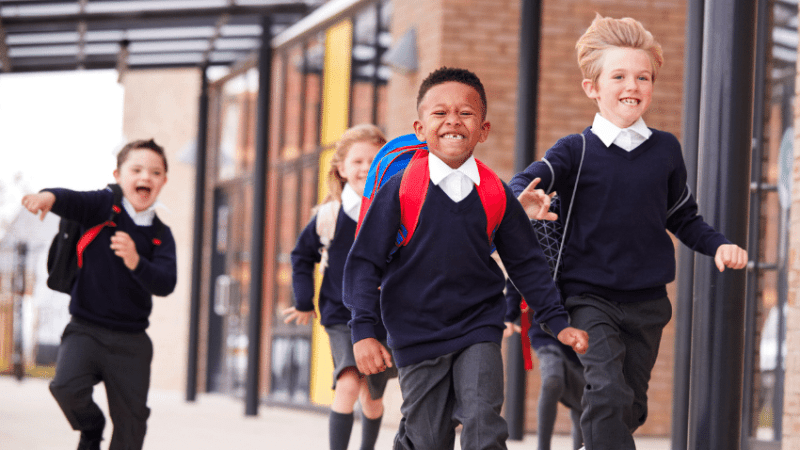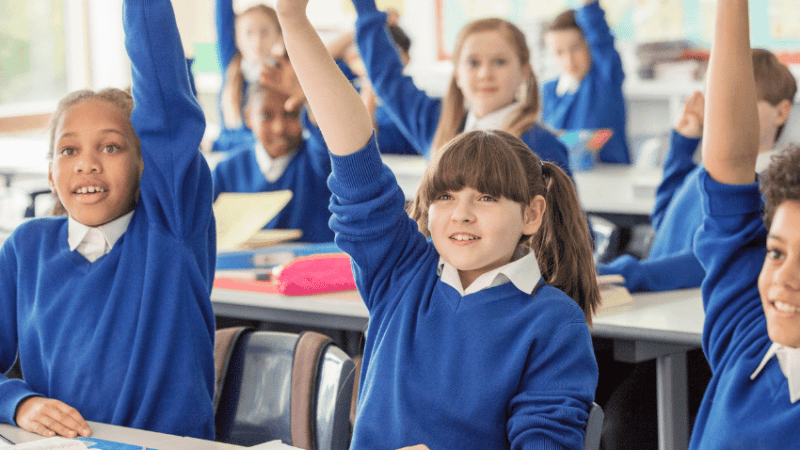Traditional tales – Best KS1 and KS2 planning and resources
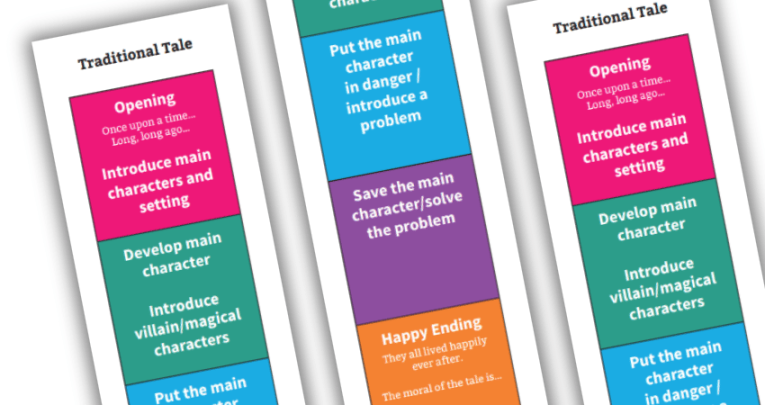
From the Brothers Grimm to the happily-ever-after Disneyfied versions, traditional tales have stood the test of time. Help pupils rewrite their own takes with these ideas…

- by Teachwire
- Classroom expertise and free resources for teachers
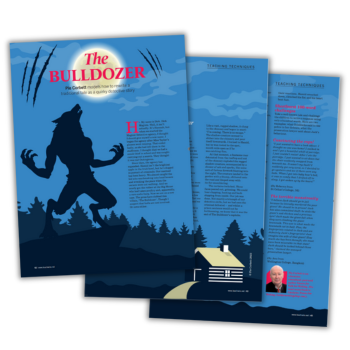
What are traditional tales and how should you teach them in KS1 and KS2? We explain everything you need to know and direct you to the best activities, lesson plans, books and resources…
- What are traditional tales?
- Does the curriculum mention traditional tales?
- Where to start with traditional tales
- KS1 traditional tales resources
- KS2 traditional tales resources
- The characteristics of traditional tales
- Three Little Pigs activities
- Retelling traditional tales
- Teaching grammar with Little Red Riding Hood
What are traditional tales?
Traditional tales, sometimes called folk tales or fairy tales, are a narrative handed down orally from one generation to another within a culture.
These stories often feature fantastical elements, magical creatures and moral lessons. Examples include stories like:
- Cinderella
- Little Red Riding Hood
- Jack and the Beanstalk
The apparently simple story lines of traditional tales generally hide a lot of subtext. Indeed, the plots may be rather dark.
Does the curriculum mention traditional tales?
Yes, in Year 1 and Year 2, pupils need to become familiar with traditional stories and how to retell them. They should learn about the particular characteristics of traditional tales.
In Year 5 and Year 6, pupils should increase their familiarity with traditional tales, both from our literary heritage and from other cultures and traditions.
Where to start with traditional tales
Using traditional tales retold in a modern format to help children understand stereotypes and challenge their perceptions.
Start by encouraging your class to think about traditional tales as a genre. Here are some questions to ask:
- What do pupils think are the main/required ingredients of traditional tales?
- How many such stories can they name?
- When and where did they first hear them?
- How are traditional tales passed from one generation to the next?
- Why do we end up with different versions of the same story?
Plot lines and vocabulary
Discuss the plot lines children would expect to find in traditional tales. What phrases and vocabulary might you here? Make a list, starting – of course – with ‘Once upon a time’. Do your learners know any traditional stories from other countries?
Morals
Traditional tales tend to have a moral of some kind. Talk with the children about what this means. Can they identify morals in the stories they’ve already discussed?
As a fun prelude to playing around with established narratives, share the book Mixed Up Fairy Tales by Hilary Robinson and Nick Sharratt with your class. Which familiar stories can pupils spot? Why does it make them funny when we mix them up together?
Modern retellings of traditional tales
- Mixed Up Fairy Tales by Hilary Robinson and Nick Sharratt (Hodder Children’s Books 2005)
- The True Story of the Three Little Pigs by Jon Scieszka and Lane Smith (Picture Puffin 1991)
- The Three Little Wolves and the Big Bad Pig by Eugene Trivizas and Helen Oxenbury (Egmont 2015)
- Princess Smartypants by Babette Cole (Puffin, 1996)
- Prince Cinders by Babette Cole (Puffin, 1997)
- The Pea and the Princess by Mini Grey (Red Fox 2004)
KS1 traditional tales resources
Explore story structure with Don’t Read This Book!
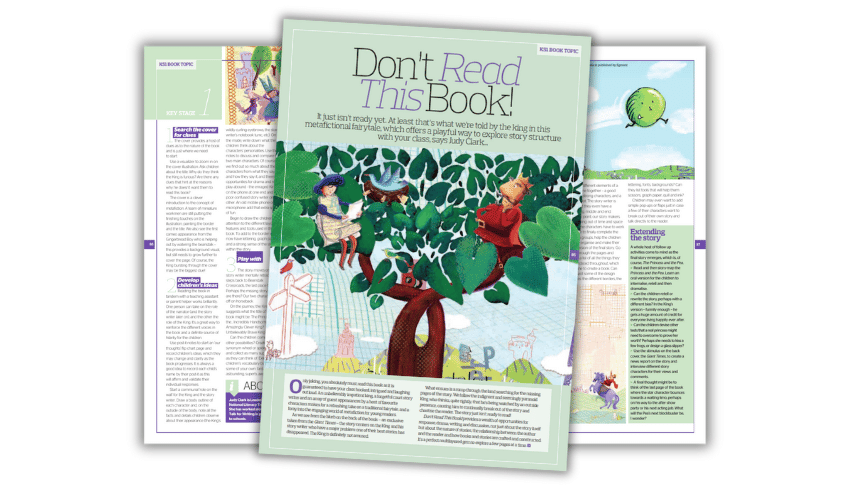
This traditional tales KS1 book topic from Judy Clark is based on Don’t Read This Book! by Jill Lewis and Debbie Allwright, a playful metafiction book that’s guaranteed to have your class hooked, intrigued and laughing out loud.
An unbelievably impatient king, a forgetful court story writer and an array of guest appearances by a host of favourite characters makes for a refreshing take on a traditional fairy tale. Explore the illustrations for clues, role-play the characters and narrator and construct your own version of the story.
Fables resource pack for Year 2
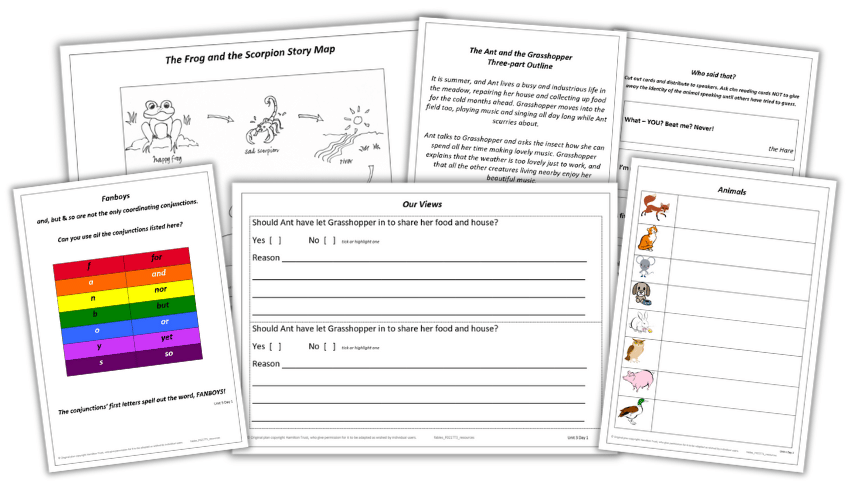
Use this free resource pack from Hamilton Trust to introduce children to animal characters in fables. Pupils will write their own dialogue between two animal characters, explore dilemmas in stories, improve comprehension and vocabulary and much more.
Explore Grimm fairy tales through drama
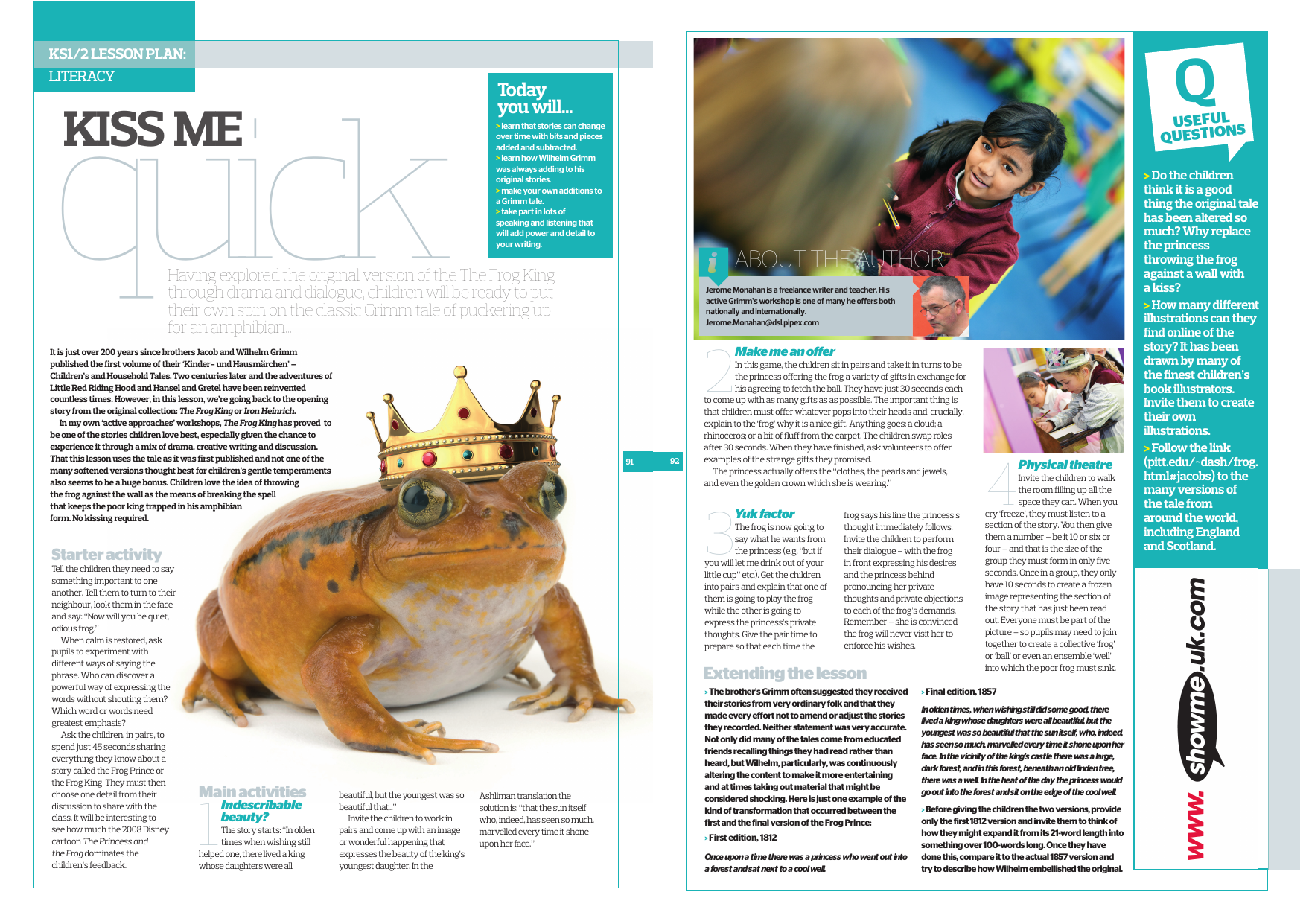
In this KS1/2 lesson students will delve into The Frog Prince through drama, creative writing and discussion.
Then, having explored the original version, children will be ready to put their own spin on the classic Grimm tale of puckering up for an amphibian.
Act out the Tortoise and the Hare
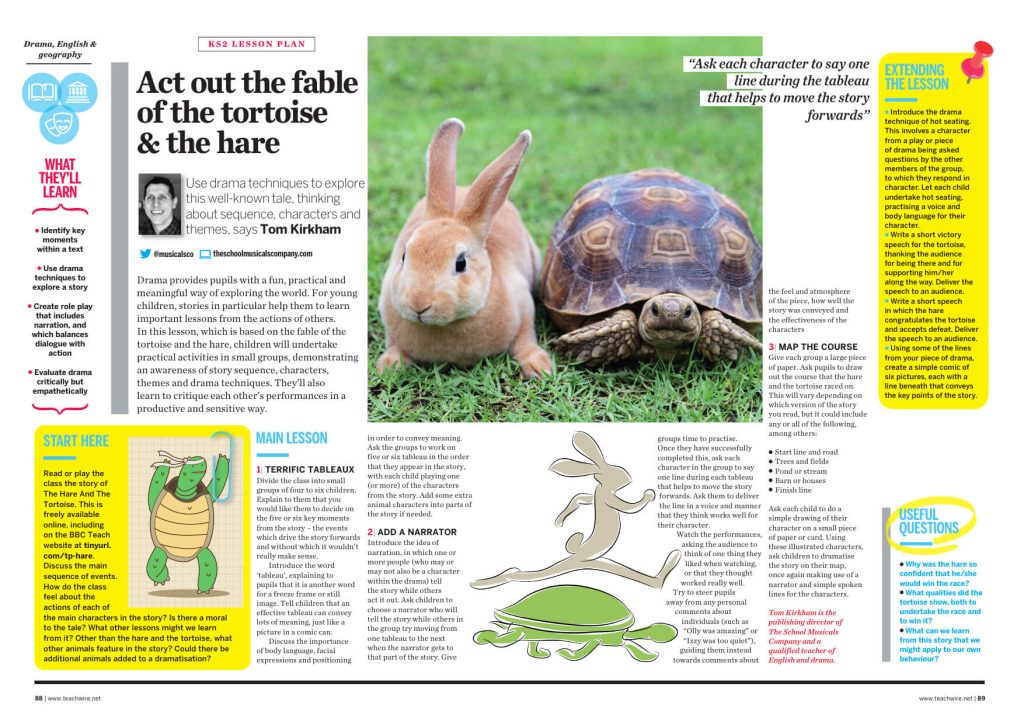
Use drama techniques to explore the ‘Tortoise and Hare’ fable in KS1, thinking about story sequencing, characters and themes. Children will undertake practical activities in small groups, demonstrating an awareness of story sequence, characters, themes and drama techniques.
Myths from around the world
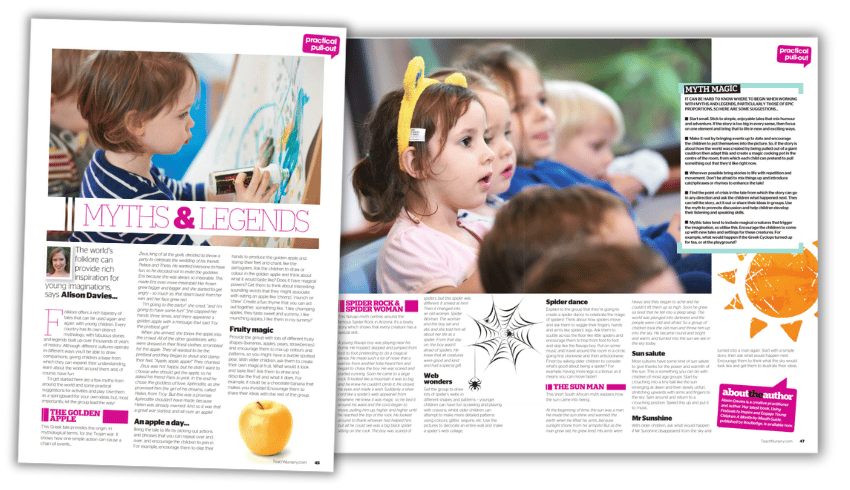
This PDF contains four myths from around the world and some creative activities and play ideas based on them. Use them as a springboard for your own ideas.
The myths are The Golden Apple (Greek), Skadi’s Tale (Norse), Spider Rock & Spider Woman (Navajo) and The Sun Man (South African).
Themed colour and write worksheets
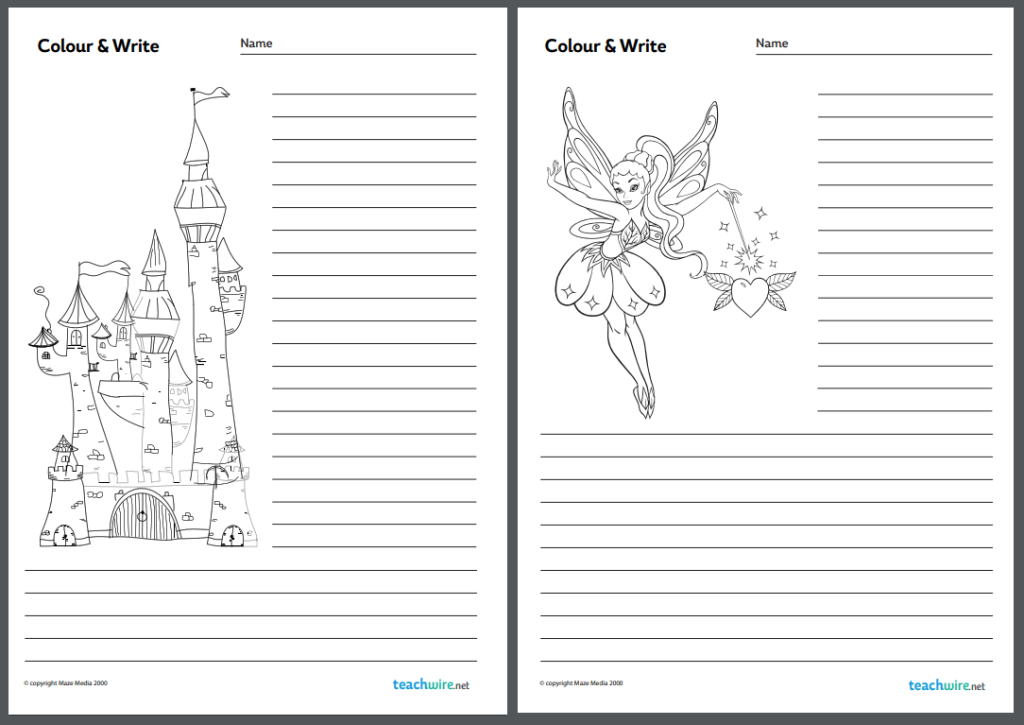
This free printable PDF contains eight pages with a different fairy tale-themed illustration for colouring in, alongside printed lines for pupils to write on. Plus, there’s an extra page without an illustration. Images include a dragon, a unicorn, a pirate, a pumpkin carriage and more.
KS2 traditional tales resources
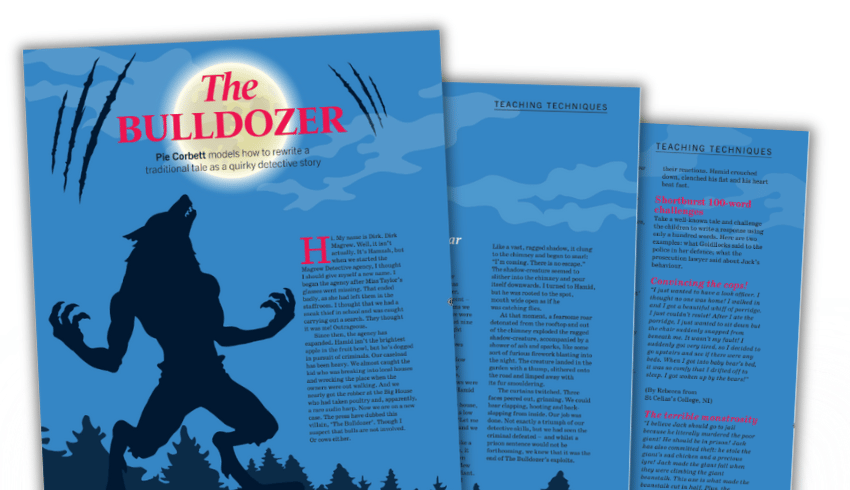
In this short story from Pie Corbett, a couple of children set up their own detective agency and get involved on the sidelines of various fairytale plots where there is an obvious villain.
Use the short story as a model text for your class. Then work through the story structure activities, created by Pie himself.
Write stories from multiple perspectives
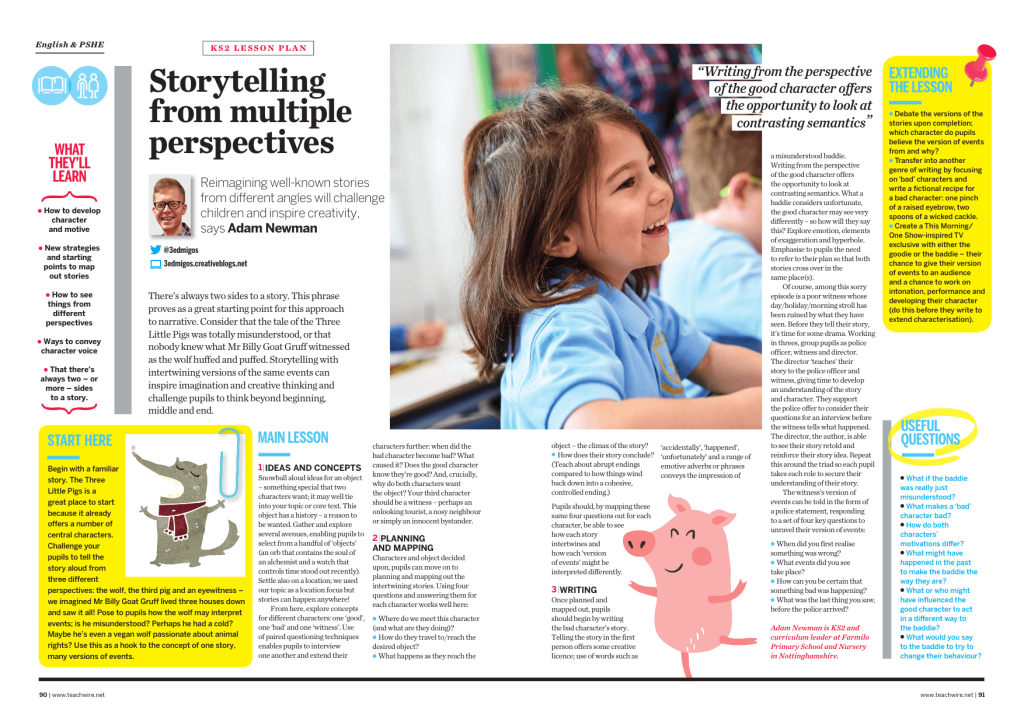
This free narrative story writing KS2 lesson plan involves reimagining traditional tales from different angles. Pupils will learn ways to convey character voice and that there’s always two – or more – sides to a story.
Aesop’s fables for LKS2

Help pupils grasp the concept of inference and what a moral is using Aesop’s fables such as The Hare and the Tortoise and The Goose That Laid the Golden Egg. This PDF contains activity ideas based around Orchard Aesop’s Fables by Michael Morpurgo and Emma Chichester Clark.
The House with Chicken Legs

The House With Chicken Legs by Sophie Anderson is steeped in traditional Russian folklore. There are endless possibilities in terms of things you can do to link learning to the book. This download features a range of cross-curricular activities based on the book.
In Their Shoes: Fairy Tales And Folktales KS2 book topic

By walking a mile in the shoes of classic literary characters, your class will go on a learning journey they’ll never forget. These cross-curricular activities from Carey Fluker Hunt explore Lucie Arnoux’s book In Their Shoes: Fairy Tales And Folktales. This book shows you a fascinating fairy-tale world of footwear, from red shoes to golden slippers and seven-league boots.
The activities allow you to delve deep into different versions of traditional tales and familiar folk stories, study picture composition and, of course, find out more about shoes of all kinds throughout history.
Fairy tales LKS2 writing planners and model text

This text types resource pack of fairy tale activities for Years 3 and 4 from literacy resources website Plazoom lets you explore traditional tales. Read the ‘Hansel and Gretel’ model text before rewriting your own version of the story.
The download includes the model text, a fairy tale writing sheet (with success criteria to support their writing), a set of fairy tale image cards, a structure/planning sheet and themed writing paper.
Traditional tales structure strip

A structure strip is a tool that supports pupils with structuring a text. It prompts them to consider what they should include in each paragraph. Our free structure strips download will help students write the perfect traditional tale.
Hansel & Gretel reading comprehension
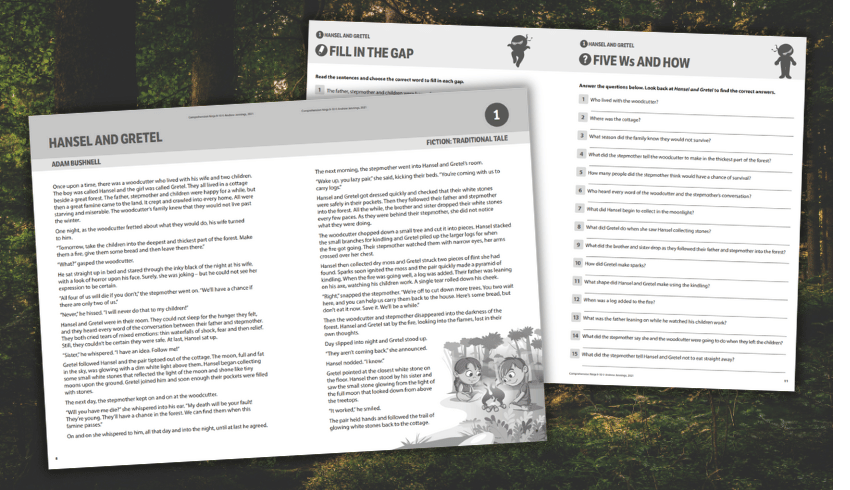
This Hansel & Gretel retelling for Year 5 comes with eight pages of comprehension questions to check pupils have fully grasped the meaning of the text.
Robin Hood extracts and activities

This resource for upper KS2 includes extracts from Robert Muchamore’s modern retelling of the classic folk hero, Robin Hood: Hacking, Heists and Flaming Arrows. There’s also corresponding discussion questions and activities.
How to write a fairy story

This BBC Bitesize quick guide features a nice brief animated video on the features of a traditional tale KS2 kids will either be familiar with or be able to understand. And there’s a little interactive quiz to try to make sure the information has stuck too.
How to rewrite fairy tales worksheet

This resource guides children on how to rewrite a traditional story, with a humorous modern retelling of the Three Little Pigs mixed with the Three Billy Goats Gruff.
Children analyse how the story has changed and use this to inspire their own retelling. It also includes planning and writing guidance.
Re-create fables as cartoon strips
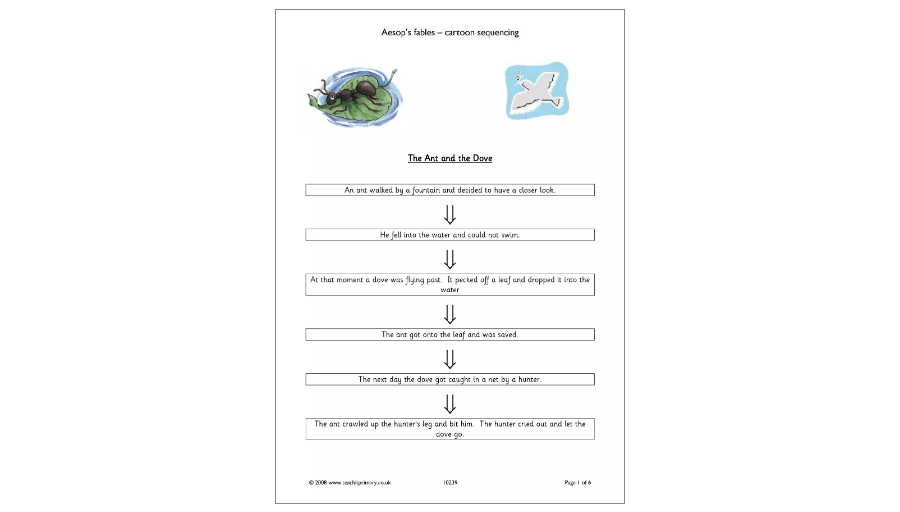
This LKS2 resource pack includes five different Aesop fables to adapt as cartoon strips. Includes an interactive sequencing activity for the fable The Mouse and the lion. The PDF includes the key plot points for the five fables, as well as a comic strip template for children to print and use.
The characteristics of traditional tales
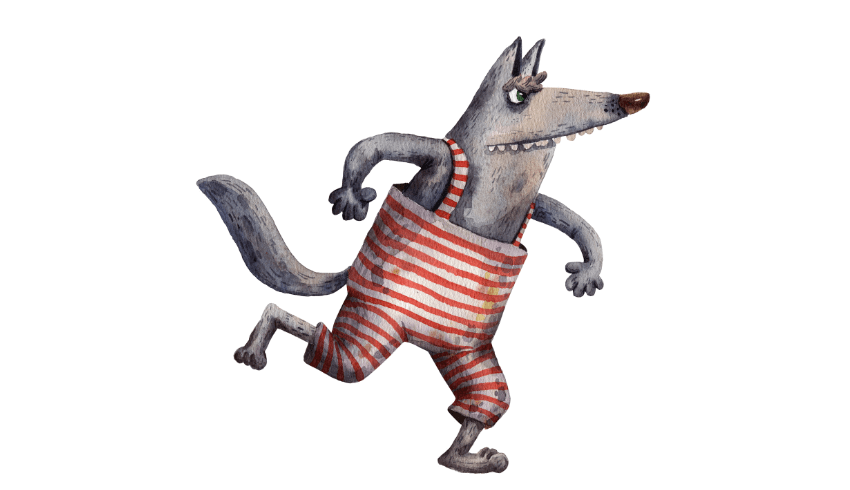
Traditional tales often revolve around a three-act structure. This makes for a simple, straightforward yet satisfying narrative arc. Learning how to structure a story with a solid beginning, middle and end is an essential skill for young writers.
Traditional tales are ideal for teaching the three-act structure as they are short, easy to summarise and analyse. They’re also broadly familiar and comfortable – even the most anxious child knows that they always end ‘happily ever after’.
However, content-wise, many traditional tales rely on two-dimensional, stereotypical characters. The villain is always 100% evil with no chance of redemption. Girls are compliant, don’t have much agency and need rescuing. Male characters are always sure of themselves, and heroic.
This is why it’s good to discuss modern, ‘twisted’ fairytales too. They often have all the things that make traditional tales the ideal vehicle to teach storytelling, but also feature more complex characters, facing issues and simply existing in a way that ensures all children feel represented in the books they read.
They also often have an unexpected twist at the end, which is fun!
Act 1 (first quarter): The Hook
We meet the characters and learn their needs and wants. The ‘inciting incident’ launches them irreversibly into the story. In Little Red Riding Hood, we discover Red’s granny is sick.
Trending
Her mum gives Red Riding Hood a basket of goodies and warns her to go directly to Granny’s, and not stray from the path.
But when Red Riding Hood meets the wolf, she stops to tell him about her gran, then she decides to pick flowers for Granny as he suggests…
Act 2 (next half): The Meat
The story unfolds, and our characters head towards almost certain disaster. The tension builds until, near the end, we have what seems like an insurmountable problem: the wolf, on learning about Granny, decides he wants to eat her.
Having distracted Red Riding Hood, he runs to Granny’s cottage where he swallows her whole. Then, dressed as her, he tries to lure Red Riding Hood close enough to eat her too, while we readers bite our nails and wonder if our protagonist will figure things out.
In the traditional fairytale, he manages to swallow her – but luckily, a brave woodcutter enters the scene.
Act 3 (last quarter): Closure
The problem is resolved, and our characters are changed from the experience. The aftermath: the woodcutter kills the wolf, splitting him in two so that Red Riding Hood and her gran can escape.
Red Riding Hood resolves to always listen to her mum in future and they live happily ever after.
Mio Debnam is the author of Adam and Little Red, one of 11 twisted fairytales from Collins Big Cat.
Three Little Pigs activities

The True Story of the Three Little Pigs
The ‘Big Bad Wolf’ tends to get a bad press – he is the villain in stories like Little Red Riding Hood and The Three Little Pigs. Why do the children think that wolves are used as ‘baddies’?
There are some delightful new versions of The Three Little Pigs, told from various different angles. In The True Story of the Three Little Pigs, an Americanised wolf explains that he was only trying to borrow a cup of sugar from the pigs, and it wasn’t his fault that he sneezed and brought their houses down.
After reading the story, talk about the language in the book. How has the original wording been adapted to create the new version? For instance, “Way back in once upon a time time” / “I huffed and I snuffed and I sneezed a great sneeze”.
Write scripts of a police interview with Alexander T. Wolf, and record these. Use the US version of the ‘Miranda Rights’ for added authenticity.
In the book, the story appears in “The Daily Pig”. Discuss how a wolf reporter might have reported the story differently. Get the children to write an alternative version for “The Daily Wolf”.
Create a talk show episode on which the wolf and the pigs appear, to be interviewed and to put their sides of the story. Your talk show could have the tagline: “Wolfie Strikes Back”.
The Three Little Wolves and the Big Bad Pig
In The Three Little Wolves and the Big Bad Pig the characters are reversed, with the wolves attacked by the pig. The building materials are modernised; as is the way the houses are demolished.
After sharing the book identify the phrases from the story that the children recognise from the original. Why does the author echo words from the traditional tale?
Explore why the author describes the wolves as “three cuddly little wolves with soft fur and fluffy tails”. How is the reader meant to feel about the wolves from this description? Get the children to write their own descriptions, using lots of adjectives.
In this version, the wolves get bricks from a kangaroo, concrete from a beaver, metal from a rhinoceros and flowers from a flamingo. Why do the children think that the author chose these particular animals? Write some descriptions of the creatures, with adjectives to help the reader understand their characters.
Discuss why the wolves choose flowers as their final building material. Was this a good choice? Why does the Big Bad Pig change his mind about eating the wolves? What is the moral here?
Retelling traditional tales
After looking at versions of traditional tales told from a different perspective, help children to develop ideas of their own with these activity ideas:
- Draw story maps of some of the original tales. Use these to identify which characters or parts of the plot you could change.
- Write a story with an alternative title, based on the familiar structure. For instance, The Three Little Flies and the Big Bad Spider.
- Compose a version of Cinderella where the ugly sisters explain why they have been misunderstood, and how they weren’t actually horrible to her.
- Create Top Trumps style cards for different fairytale characters. Adapt these so that they are the opposite of what we would normally expect.
- Come up with a version of a story where the traditional ‘villain’ is swapped with the traditional ‘hero’. For instance, three trolls trying to get over a bridge that has an evil goat lurking below.
- Rewrite a traditional story from the viewpoint of an inanimate object (see The Pea and the Princess for inspiration).
- Dramatise some scenes in which various fairytale characters appear in surprising incarnations – as happens in the popular Shrek film series.
- Look at some traditional tales from other cultures. How are these similar and different to stories from Britain? Which parts of the narratives might we change to update them?
Teaching grammar with Little Red Riding Hood
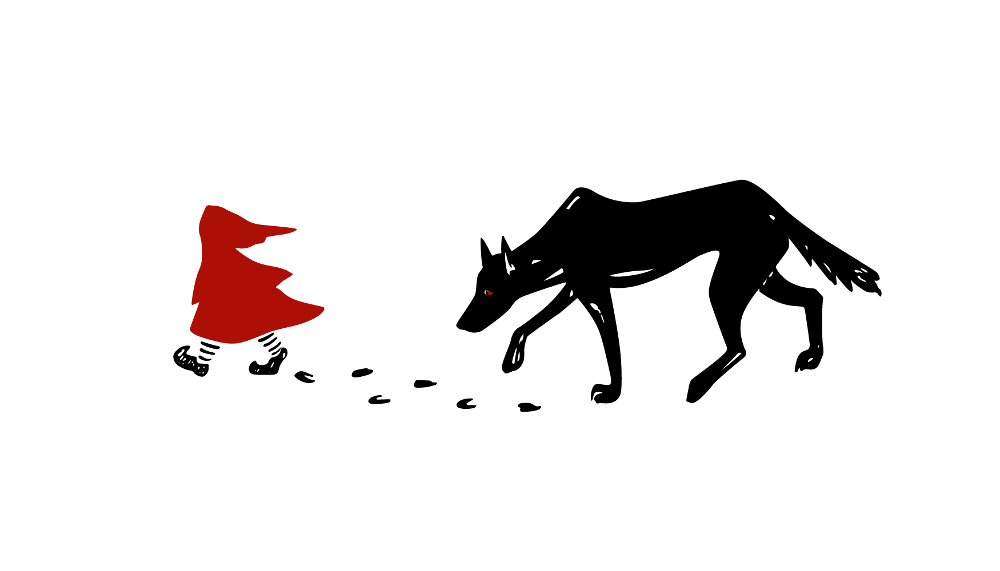
Changing just one word can transform the impact of a sentence – and take familiar traditional tales somewhere new and exciting, explains Kate Ruttle…
There are many ways to explore how the use of grammar in Little Red Riding Hood makes an impact on the reader.
- Identify the words/sentences the writer uses.
- Use drama, with group or paired activities, to explore possible alternatives.
- Discuss the impact of the different options and decide why the writer chose to use the words and sentences that are in the text.
The same steps can be used with any suitable text, as can all these activities.
1 | Changing nouns and verbs
Consider this sentence: In the woods, she met a wolf.
Identify the nouns in the sentence (woods, wolf). Which words might replace the noun ‘wolf’ if you changed ‘woods’ to, for example, ‘pool’ / ‘desert’ / ‘park’ / ‘Arctic’ / ‘classroom’ / ‘lake’?
Point out that we are limited in the kinds of words we can use instead of ‘wolf’ (we can only use nouns or noun phrases). The choice of the first noun (place) will affect the choice of the second noun.
Now identify the verb (met). Remind children that a sentence must have a verb. Which words could you use instead of ‘met’ (e.g. spotted, glimpsed, ran from, shouted at)?
Talk about how the verb sets up expectations of what happens next in the story. For example, if Little Red Riding Hood ‘spotted’ a wolf, we know that the wolf is hiding, or is perhaps a long way away. How will that affect what happens next?
2 | Playing with sentence types
The story of Little Red Riding Hood has the full range of sentence types:
- Questions – “Where are you going with that basket of goodies?”
- Statements – “My grandmother lives in the cottage in the woods.”
- Explanations – “What big ears you have!”
- Commands – “Lift up the latch and come in.”
Play with the words in each kind of sentence. How do you change one sentence into a different kind of sentence? How would it change the story if, for example, Little Red Riding Hood had asked “Why do you have such big ears, Grandmother?” or commanded “Show me your big ears.”?
Allow the children to play with speech bubbles of sentences throughout the story, using the same kind of information but in different sentence types. Talk about the reasons why particular sentence types are used at each point in the story.
3 | Tracking fronted adverbials
Adverbials are interesting because, unlike most word-types, they can move around a sentence. Ask children to consider the difference between
- Later that morning, she arrived at her Grandmother’s cottage.
- She arrived later that morning at her Grandmother’s cottage.
- She arrived at her Grandmother’s cottage later that morning.
The same words are used in all the sentences, and the broad meaning is the same. However, each sentence means something slightly different because the emphasis changes according to where in the sentence the information is included. Is the emphasis in the sentence meant to be on her arrival, or when she arrives?
Discuss the fact that we normally start a new paragraph if there is a new time, place, person or action. That being the case, which of the sentences is most likely to be used at the beginning of a paragraph? Talk about why.
Let children search for adverbials throughout the text. Where are fronted adverbials mostly used? Note that if there is a fronted adverbial, it often means that there should also be a new paragraph.
4 | Acting out modal verbs
Ask the children to try some of the dialogue in Little Red Riding Hood with lots of modal verbs, eg
- “I might go later, if I have time,” mumbled Little Red Riding Hood.
- “No, you must go now while the cakes are still warm,” insisted her mother.
- “But I should be at Goldilocks’ house!” complained Little Red Riding Hood.
Let the children use drama to explore how using different modal verbs in dialogue at key points in the story changes the relationship between the characters.
Activities that engage children with grammatical structures, and which make them question and explore their use, are likely to improve standards in children’s own writing far more effectively than decontextualised sentence-writing in weekly grammar lessons.
Kate Ruttle is a literacy consultant and primary school teacher of 30 years. She has written the Cracking Comprehension and Cracking Writing resources for Rising Stars.






